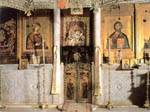|
|
| Byzantine Sculpture |
10th c., 2nd half Karyes, Protaton Marble, 3.50 x 14 m |
|

|
One of the oldest marble templa on Mount Athos and the only one to survive intact in its original place. It is a high, tripartite screen, typical of the form which evolved in Byzantine churches after the Iconoclast period. It consists of eight colonnettes - four in the central section and two in each of the lateral sections - supporting an epistyle, the intercolumnar spaces below being closed by panels. The central section of the chamfered face of the epistyle is decorated with an undulating tendril, the diaconicon section with continuous arches framing palmettes (the 'Asia Minor motif'), and the prothesis section with interconnected roundels enclosing palmettes and rosettes. The jambs of the sanctuary doors are decorated with the common Byzantine motif of the undulating tendril with half-palmettes, and the colonnettes with rows of squares linked by knots; the upper square encloses a cross, the others alternately a clover-leaf and a palm-leaf. The capitals of the colonnettes at either end are simple octagons; these of the central section have a pyramidal form and are decorated with either lanceolate leaves or highly stylised palmettes on the faces, and vertical stems with pine-cones at the edges. The lower intercolumnar spaces to the left and right of the Royal Door are closed by twin panels, each divided in the middle by a stylised chevron pattern culminating in a cross. Each compartment is ornamented with a geometrical pattern which is a common motif on middle-Byzantine closure panels. Specifically, a triple band of bosses forms an inscribed lozenge and circles, one large one in the centre and four smaller ones in the corners. The central circles contain alternately a concave multiple rosette or a composite lemniscus. The smaller circles in the corners are also supplemented with multiple and star-shaped rosettes and firewhirls. On the partition walls of the sanctuary are two plaster icon-stands, composed of two double knotted colonnettes crowned with pyramidal capitals decorated with five-leaved palmettes. The capitals support a chamfered arch decorated with a zig-zag pattern that forms triangles enclosing small palmettes. The reliefs on this templon are characterised by a lack of stylistic coherence and a tendency towards simplification, like the reliefs on other Macedonian monuments from this period; they should therefore be connected with local workshops, rather than directly with Constantinople. As far as the dating is concerned, Brιhier (1940) and Orlandos (1953) place it in the tenth century, while Grabar (1976) prefers a dating around 1000. Mylonas, however, without offering any specific proof, argues that the templon could belong to the end of the ninth century or be an early tenth-century addition, since, he says, hosios Athanasios found it in situ, and in fact partially walled it up when he was enlarging and renovating the Protaton around 965 (Mylonas 1979, p. 146). All the same, whether Athanasios' work on the monument involved restoring an earlier church or building a new one, it could also have included the construction of a marble templon, because, according to his Life, the church acquired 'beauty as well as size'.
| |
|
Bibliography: Brιhier 1940, pp. 45-6. Orlandos 1953, pp. 83-91, figs. 1-5. Grabar 1976, no. 61, p. 68. Mylonas 1979, p. 146, pls. 3-4, 10-11.
| ||
| T.N.P. | ||
| Index of exhibits of Protato 10th century |
||
Reference address : https://www.elpenor.org/athos/en/e218bf1.asp